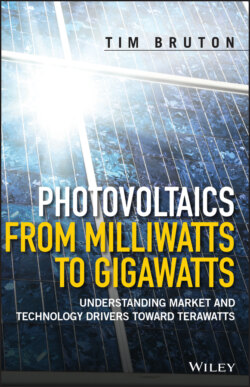Читать книгу Photovoltaics from Milliwatts to Gigawatts - Tim Bruton - Страница 18
1.3.1 First Commercial Operation
ОглавлениеThe combination of good results from actual satellite flights and the potential to achieve efficiencies as high as 30% in the long term provided a good platform for the continued use of solar cells in space. In 1959, Hoffman Semiconductor supplied 9600 p on n solar cells, 1 × 2 cm, to the Explorer 6 satellite. The cells were mounted on four paddles, which deployed from the satellite’s equator. Explorer 6 took the first pictures of earth from space [45]. A further step forward was the launch of the first commercial telecommunications satellite, ‘Telstar’, in 1961. This was a project of Bell Telephone Laboratories, first proposed in 1955 [39]. When launched, Telstar utilised the latest development in solar cells for space [46]. Its cells were made by the Bell subsidiary Western Electric. Radiation resistance was the first parameter to be studied, and the researchers confirmed the earlier observation that n on p cells were 10 times more resistant that the original p on n cells. Their results are shown in Figure 1.7.
The figure shows the clear superiority of the blue‐sensitive (i.e. shallow junction) phosphorus‐diffused n on p solar cell. The short‐circuit current provides a good indicator of the underlying electronic quality of the silicon material in the cell. Further radiation protection was provided by a 750 μm‐thick sapphire cover glass. The next objective was to optimise the efficiency of the solar cell. It was found that the highest efficiencies were achieved with silicon wafer doping at 1 Ω/cm. Next, diffusion was optimised: while lighter diffusions improved blue response (with 90 Ω per square being an optimum), the cells were prone to electrical shunting. A final diffusion range of 30–60 Ω per square was thus adopted. Finally, improvements were made to the metallisation. While the original Bell cells had all the metallisation on the rear, Wolf at Hoffman had shown that a gridded pattern on the front increased solar cell efficiency [47]. Five grid lines (150 μm wide) per cell were applied. A schematic of the Telstar cell is shown in Figure 1.8.
As well as adopting a grid structure, the metallisation was changed to give a better contact. The electroplated nickel of the original cell was replaced by an evaporated titanium contact as the nickel plating still gave problems even with the diffusion compromise. On sintering, the titanium reduced the native silicon dioxide coating to make contact with the n type emitter. The titanium contact was coated with silver to prevent oxidation and provide a good surface for soldering. Another parameter to be considered was thermal shock and the range of operating temperatures. Under normal operation, the solar cell temperature would varying between 10 and −50 °C, although at certain times this could extend to 100 to −69 °C . This could cause cracking in the solar cell. It was found necessary on the rear contact to mask the cell edges in order to leave an uncoated border to avoid cracking. Two cells 1 × 2 cm were cut from a 1 inch‐diameter silicon wafer. A silicon dioxide antireflection coating was applied by evaporation. In a run of 10 000 cells, the efficiency at 100 mW/cm2 insolation, 28 °C, and a fixed load point at 0.45 V had a median efficiency of 10.8%. A typical I/V is shown in Figure 1.9. 3600 cells were used for the satellite, in 50 parallel strings of 72 cells, to give a total power of 14 Wp.
Figure 1.7 Decrease in short‐circuit current of n on p and p on n silicon solar cells for different fluxes of 1 MeV electrons [46]
(Source Bell System Technical Journal)
Figure 1.8 Schematic of the Telstar silicon solar cell [46]
(Source Bell System Technical Journal)
Figure 1.9 Current–voltage curve for a Telstar cell at 28 °C at 100 mW/cm2[46]
(Source Bell System Technical Journal)
The satellite mission was successful, although radiation damage was extensive and the solar cell output decreased to 68% of its original value after 2 years in orbit. It was calculated that even with the state of the art, additional solar cells could be deployed to give a 20‐year life without significant weight penalties.
The Telstar cell provided a basis for further silicon development. The n on p structure was readily manufactured and the diffusion range of 30–60 Ω/cm on a 1 Ω/cm silicon wafer became the standard for terrestrial solar cells for many years. The only significant difference between the Telstar cell and later terrestrial cells was that Telstar used (111) orientation wafers while the later cells used (100) orientation, which could be chemically textured as discussed in the next section.
